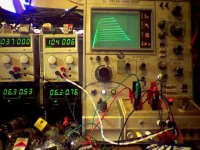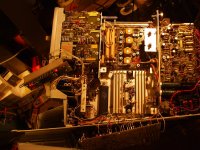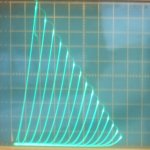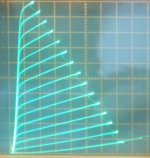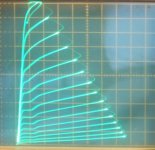As soon as the SOFIA was available from Italy in 1996 I snapped it up. Mine was the first one shipped to a US Customer. I am an Electronic Engineer so mine still works (and with my Engineering Salary I could afford it). Kent Leach got the one that Svetlana had here in Cali; mine is DOS his is Windows 3.1. Kent dug up the Schematics for the SOFIA and was kind enough to provide them to me. Its Software provides matching based on the entire set of curves; so it is by far the best investment for improving my Audio. I have tested thousands of tubes on it.
Eleven years ago (!) I replied to this thread that I preferred the Triplett 3444 for regular use. I had read the raves given to the AVO VCM163 by EC8010 and others. A few years ago I found a VCM163 in nice condition. It has replaced my 3444 as my "go to" tube analyzer. It is the easiest to use of my tube analyzers and, being solid state itself, seems to be stable and free of drift. I like how it displays plate current and transconductance simultaneously on its two meters. When comparing and grading tubes of one type, oftentimes low transconductance is found to be due to low plate current. A nudge in the grid bias to restore the specified plate current often restores gm to satisfactory levels. Whether this nudge is useful will depend on how a tube is used in circuit.
For serious tube analysis I agree that a curve tracer is the way to go. I have picked up relic Tek 577 and 576 carcasses on the cheap, and made working units out of them. One must provide a tube socket interface plug-in fixture, and an outboard heater supply. For tetrodes and pentodes an outboard screen supply must also be attached. A 576 can provide all the plate voltage and current one could ever need for audio projects. Restoring these old Tek beasts is not for the faint of heart, especially when one encounters a bad CRT or a failed power transformer, as a friend of mine experienced. Newer Tek curve tracers are frightfully expensive though.
A curve tracer usefully reveals how plate curves behave in various regions of plate current and plate voltage. For example one might see crowding of the curves at high plate voltages and low currents, indicating the potential for distortion, which can be fairly easily calculated from the curves, the second harmonic especially. Often the curves will not look as textbook-pretty as the tube manual suggests, but the observed curves will guide best choices for quiescent operating point and load lines. One can calculate mu and gm from these curves of course, but, for sorting out good tubes to stick into a commercial product, an analyzer of the VCM163/3444/539C variety is far easier to use.
For kicks I have also collected a couple of "laboratory" tube analyzers, the New London 901A and an RCA WT-100A. These add zero capability beyond what the VCM163 and 576 together can provide, but they are retro cool. Both have long awaited restoration...
For serious tube analysis I agree that a curve tracer is the way to go. I have picked up relic Tek 577 and 576 carcasses on the cheap, and made working units out of them. One must provide a tube socket interface plug-in fixture, and an outboard heater supply. For tetrodes and pentodes an outboard screen supply must also be attached. A 576 can provide all the plate voltage and current one could ever need for audio projects. Restoring these old Tek beasts is not for the faint of heart, especially when one encounters a bad CRT or a failed power transformer, as a friend of mine experienced. Newer Tek curve tracers are frightfully expensive though.
A curve tracer usefully reveals how plate curves behave in various regions of plate current and plate voltage. For example one might see crowding of the curves at high plate voltages and low currents, indicating the potential for distortion, which can be fairly easily calculated from the curves, the second harmonic especially. Often the curves will not look as textbook-pretty as the tube manual suggests, but the observed curves will guide best choices for quiescent operating point and load lines. One can calculate mu and gm from these curves of course, but, for sorting out good tubes to stick into a commercial product, an analyzer of the VCM163/3444/539C variety is far easier to use.
For kicks I have also collected a couple of "laboratory" tube analyzers, the New London 901A and an RCA WT-100A. These add zero capability beyond what the VCM163 and 576 together can provide, but they are retro cool. Both have long awaited restoration...
Last edited:
It looks like most of us will have to build our own. Heater voltage can be selected using a switching regulator. These are more common and easier to use than they were 10 years ago. That eleiminates the need for a "tube tester" transformer with all th0se heater taps. Wouldn't it be nice to be able to type in the number of the tube and have everything set up automagically from that?
The Stark 9-66 does a good job for people in Canada. The ancient TV-2/u probably has the most flexibility, but these devices only give you static numbers. The 9-66 does operate the tube dynamically, just like the Hickok units it is based on. You do the best you can with what you have.
-Chris
The Stark 9-66 does a good job for people in Canada. The ancient TV-2/u probably has the most flexibility, but these devices only give you static numbers. The 9-66 does operate the tube dynamically, just like the Hickok units it is based on. You do the best you can with what you have.
-Chris
It looks like most of us will have to build our own.
-Chris
This could be a very simple, yet very accurate set up. I've had to rig up simple test fixtures in the past to measure the characteristics of RF power tubes requiring high voltages not available on tube analyzers. I used separate variable power supplies for plate, grid bias, heater and (maybe) the screen. An ammeter is inserted in the plate lead. You can, somewhat tediously, vary the plate supply and grid bias and trace out the plate curves, one point at a time. Or if you simply want to check mu, rp and gm at a specific operating point, set up that point and vary grid bias in small increments from that point to calculate gm; likewise vary the plate voltage to assess rp. Of course, having any two known parameters yields the third.
Last edited:
With the price of tube testers being up where they are, you would be better off getting a much more capable curve tracer for less $$. The Tek 576 can be converted for tube use (below), but requires a fair amount of work and extra expenses. (I have the revision work mostly documented on the one I converted)
The online Mu Tracer kit is much more affordable and easier to get going, plus it lets you save results on the PC. It doesn't give you the high currents needed for many output tube tests. (Each rev. has been getting more capable though).
The online Mu Tracer kit is much more affordable and easier to get going, plus it lets you save results on the PC. It doesn't give you the high currents needed for many output tube tests. (Each rev. has been getting more capable though).
Attachments
Last edited:
- Status
- This old topic is closed. If you want to reopen this topic, contact a moderator using the "Report Post" button.
